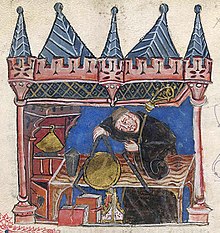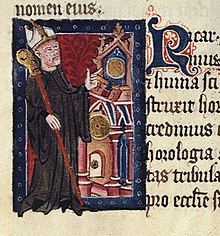Richard of Wallingford
Richard von Wallingford (* 1292 in Wallingford ; † 1336 in St Albans ) was an English mathematician who made great contributions to astronomy , astrology and watchmaking while he served as abbot in St Albans Abbey in Hertfordshire .
He was born in Wallingford , Berkshire (now Oxfordshire ) to a blacksmith . When he was orphaned, he was brought to live with William de Kirkeby, Prior of Wallingford. Richard then studied for six years at the University of Oxford before becoming a monk at St Albans. He later studied at Oxford for a further nine years. In 1326 he became abbot of St Albans.
Richard von Wallingford is known for the astronomical clock he designed , which is described in the Tractatus Horologii Astronomici (1327). The clock was completed by William of Walsham about twenty years after his death. About two hundred years later (1539) it was destroyed during Henry VIII's dispute with the Catholic Church, the so-called English Reformation and the subsequent dissolution of the English monasteries . His watch was certainly the most complex watch mechanism that existed in the British Isles at the time and one of the most advanced watches in the world. It was characterized by a 24-hour circle on the dial and the graphical display of the moon and sun during the night and day. The only other documented clock-like mechanism from the 14th century with comparable complexity is the "Astrarium" by Giovanni de Dondi . Various clock historians of the 20th century have tried to build a replica of the clock based on the traditions from the 14th century. The most famous of these replicas was exhibited for many years in the now closed Time Museum in Rockford , Illinois ; another was built by watchmaker Eric Watson and is now in the Wallingford Museum; a third, built in 1988, is in St Albans Abbey .
Richard von Wallingford also designed and constructed a calculating machine known as the Equitorium , which he himself called Albion . With their help, astronomical calculations could be carried out, geographic longitudes of the moon, sun and planets could be determined and occultations could be calculated in advance. The machine is described in the Tractatus Albionis . He also published other writings on trigonometry, star coordinates, astrology and various religious works.
Richard suffered from a disease that in his day was mistaken for leprosy (although it may have been syphilis , scrofula, or tuberculosis ), which he apparently kept quiet when he was appointed abbot in Avignon by the Pope. He died in St Albans .
swell
- John David North : God's Clockmaker: Richard of Wallingford and the Invention of Time . Oxbow Books, 2004. ISBN 1852854510 .
- John David North: Richard of Wallingford . Volume I-III. Oxford Univ. Press. 1976. ISBN 0198581394 .
- E. Watson: The St Albans Clock of Richard of Wallingford . Antiquarian Horology, Number 4, Volume 11, 1979, p. 372-384.
- www.stedmundsbury.gov.uk Astronomical clock
- www.nicholaswhyte.info Nicholas Whyte: Richard von Wallingford's astronomical clock (essay, English)
Web links
- The Wallingford Clock at St Albans Cathedral
- The Astronomical Clock of Richard of Wallingford
- Royal Berkshire History: Richard of Wallingford
| personal data | |
|---|---|
| SURNAME | Richard of Wallingford |
| BRIEF DESCRIPTION | English clergyman, astronomer and clockmaker |
| DATE OF BIRTH | 1292 |
| PLACE OF BIRTH | Wallingford |
| DATE OF DEATH | 1336 |
| Place of death | St Albans |

